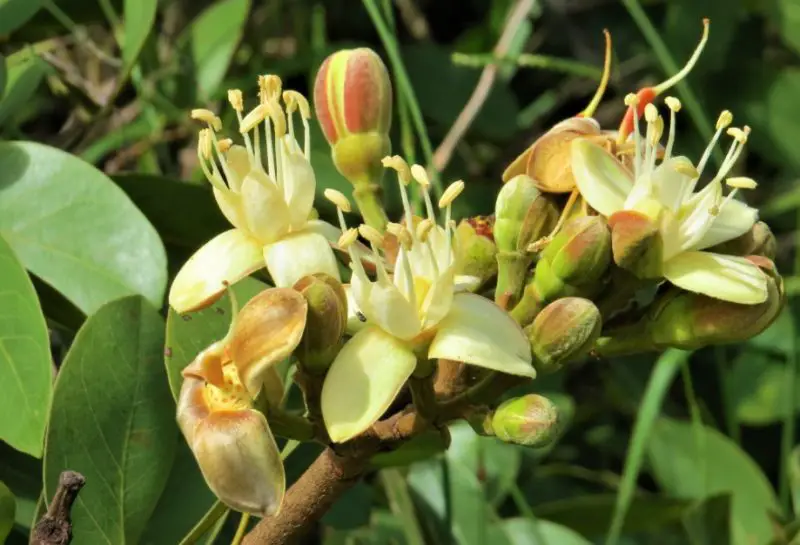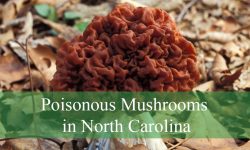Looking to add a burst of sunshine to your garden or landscape? Trees with Yellow Flowers are a vibrant and eye-catching way to bring life, warmth, and beauty to any outdoor space. These radiant trees bloom with golden, buttery, or lemon-colored blossoms that not only brighten your surroundings but also attract pollinators like bees, butterflies, and hummingbirds.
Whether you’re searching for tropical varieties that thrive in warm climates or cold-hardy species suited for temperate zones, this guide covers 58 stunning types of trees with yellow flowers, complete with pictures and identification tips. From small ornamental trees to towering shade providers, there’s a perfect yellow-flowering tree for every garden.
In the following list, you’ll discover detailed descriptions, flowering characteristics, USDA growing zones, and visual identifiers to help you choose the right tree for your landscape. Dive into the world of trees with yellow flowers and find your next favorite showstopper!
Different Types of Trees with Yellow Flowers
Golden Shower Tree (Cassia fistula)
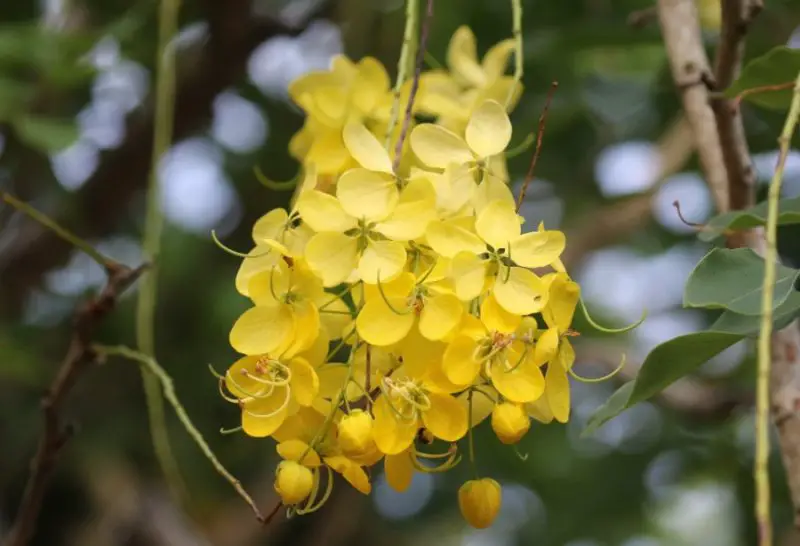
The Golden Shower Tree is a stunning ornamental tree known for its cascading clusters of bright yellow flowers that bloom in late spring to early summer. Native to the Indian subcontinent, it is widely planted in tropical and subtropical regions due to its striking floral display. The tree has pinnate leaves and a moderate growth rate, making it ideal for landscaping in warmer climates.
This tree can grow up to 30 to 40 feet tall and develops a rounded or irregular canopy. It prefers full sun and well-drained soils, though it can tolerate brief periods of drought once established. Its showy yellow flowers hang like golden chains, giving it the nickname “Indian Laburnum.” After blooming, it produces long, dark seed pods.
Golden Shower Tree is best suited for USDA hardiness zones 10 to 12. It is commonly planted along streets, in gardens, and in public parks where it draws attention during its flowering season. While deciduous in nature, it often remains semi-evergreen in tropical areas.
Yellow Trumpet Tree (Tabebuia aurea)
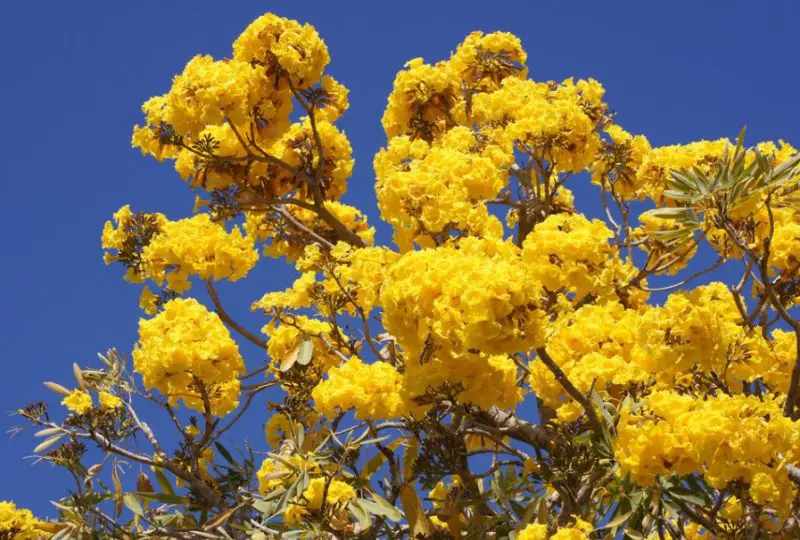
The Yellow Trumpet Tree, also known as Silver Trumpet Tree, features vibrant golden-yellow, trumpet-shaped flowers that appear in profuse clusters before the leaves emerge. Native to South America, this tree is admired for both its flowers and its silvery-gray foliage and bark. The contrast makes it an eye-catching addition to any landscape.
Typically reaching 20 to 30 feet in height with a spreading crown, this tree thrives in full sun and prefers well-drained, sandy or loamy soil. It’s drought-tolerant once established, making it a great choice for xeriscaping. The blooms attract bees and other pollinators and usually appear in early spring.
Yellow Trumpet Tree is suitable for USDA hardiness zones 9 to 11. It’s often used as a focal point in gardens or planted along avenues for seasonal color. It may drop its leaves during dry spells but quickly rebounds with a burst of brilliant flowers.
Silk Cotton Tree (Cochlospermum religiosum)
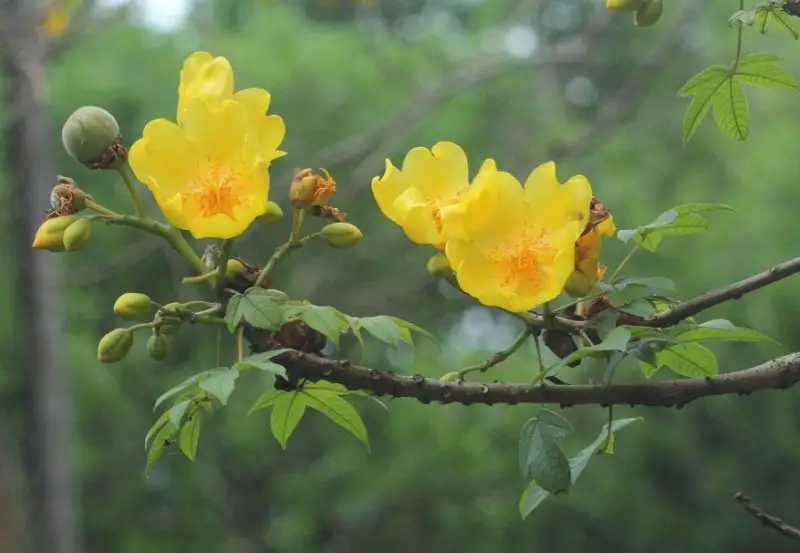
The Silk Cotton Tree, also known as the Buttercup Tree in some regions, is native to India and Southeast Asia. It is notable for its bright yellow, five-petaled flowers that bloom on bare branches before the leaves appear, usually in late winter or early spring. The flowers are large, showy, and resemble buttercups in shape.
This deciduous tree typically reaches heights of 25 to 40 feet, with a somewhat irregular branching pattern and a thick trunk. The tree produces lightweight, cottony seeds encased in woody pods, which gave it the common name. Its coarse, lobed leaves emerge after the flowering period.
Silk Cotton Tree grows best in USDA zones 10 to 12. It is well adapted to dry and arid conditions and is commonly planted in temple grounds, along roadsides, or in large gardens for its dramatic seasonal flowering display.
Golden Wattle (Acacia pycnantha)
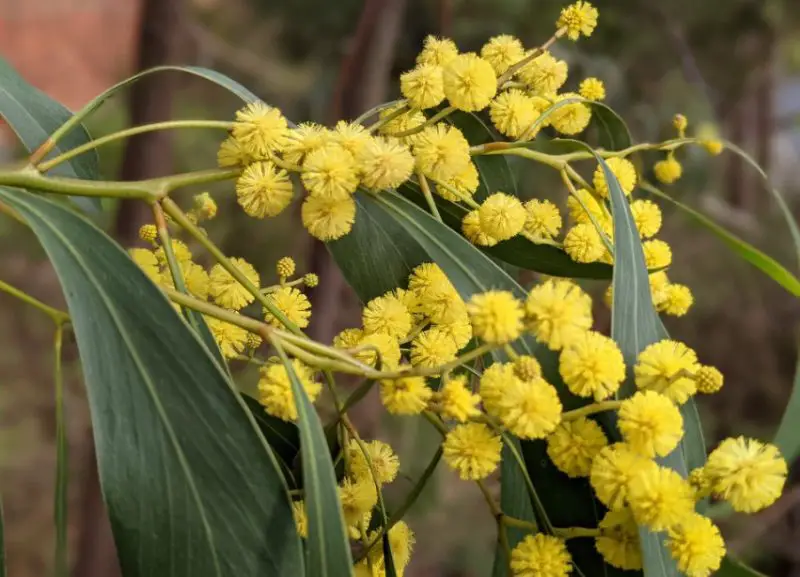
Golden Wattle, Australia’s national floral emblem, is a fast-growing shrub or small tree known for its fluffy, golden-yellow flower clusters. These fragrant flowers bloom in late winter to early spring and attract bees and butterflies. The tree has slender phyllodes (leaf-like structures) instead of true leaves.
This species typically grows to a height of 15 to 30 feet and features a bushy, rounded form. It is well-suited to a variety of soils, including sandy and poor soils, and it thrives in full sun. Its ability to fix nitrogen makes it beneficial for soil improvement in degraded landscapes.
Golden Wattle is hardy in USDA zones 9 to 11. It’s often planted in native gardens, parks, and roadside revegetation projects. In some non-native areas, however, it has become invasive, so care should be taken when introducing it outside its natural range.
Yellow Flame Tree (Peltophorum pterocarpum)

The Yellow Flame Tree is a spectacular tropical tree known for its large, feathery, golden-yellow flower clusters that bloom in late spring and summer. The flowers are arranged in upright panicles and have a slight ruffled appearance. Native to Southeast Asia, this tree is widely used as a shade and ornamental tree.
It typically reaches 50 to 65 feet in height and has a broad, spreading crown. The bipinnate leaves are lush and fern-like, adding to its ornamental appeal. After flowering, it produces flat, brown seed pods. This tree is deciduous or semi-evergreen, depending on the climate.
Yellow Flame Tree is best suited for USDA zones 10 to 12. It thrives in full sun and well-drained soil and is commonly seen in large gardens, along roadsides, and in public parks. Its rapid growth and generous canopy make it an excellent shade tree.
Buttercup Tree (Cochlospermum vitifolium)
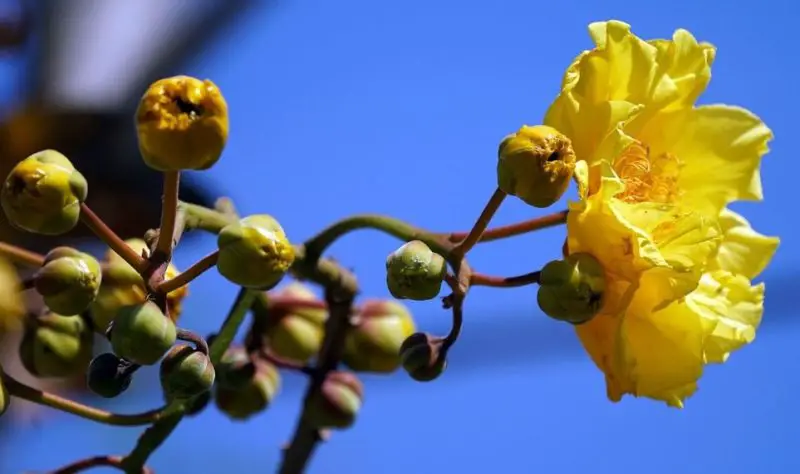
The Buttercup Tree is a tropical beauty known for its large, butter-yellow flowers that resemble hibiscus blooms. The flowers appear singly or in small groups on leafless branches, creating a dramatic floral display in late winter to early spring. Native to Central and South America, it is valued for its ornamental charm.
This deciduous tree grows up to 20 to 30 feet tall and features coarse, grape-like leaves that emerge after flowering. It prefers full sun and does well in sandy, well-drained soil. The tree also produces light cottony seeds inside woody capsules, which disperse easily in the wind.
Buttercup Tree is suitable for USDA hardiness zones 10 to 11. It is commonly planted as a specimen tree in tropical gardens or dry landscapes. Its seasonal flowering and unique leaf structure make it a standout addition to any warm-climate garden.
Yellow Oleander Tree (Thevetia peruviana)
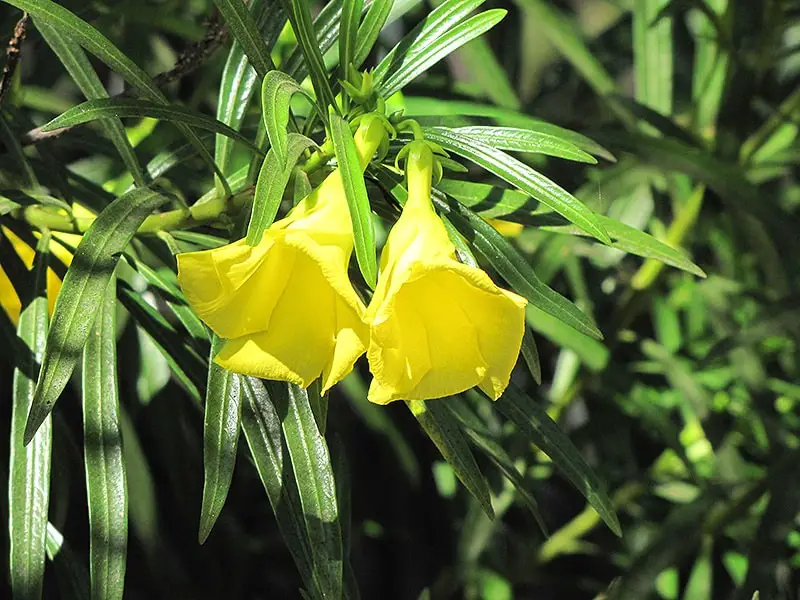
The Yellow Oleander Tree is a small, ornamental tree or large shrub known for its bright, funnel-shaped yellow flowers that bloom throughout the year in warm climates. Native to Mexico and Central America, it’s often grown for its vibrant appearance and tolerance to heat and drought. Its glossy green leaves contrast beautifully with the vivid blossoms.
Typically growing 10 to 20 feet tall, this tree develops a dense, rounded canopy. It prefers full sun and well-drained soils and is often planted as a hedge, screen, or specimen tree. Though visually appealing, all parts of the tree are toxic, especially the seeds, and care should be taken when planting it near children or pets.
Yellow Oleander thrives in USDA hardiness zones 9 to 11. It performs best in tropical and subtropical climates, and its nearly year-round flowering makes it a favorite in coastal gardens, roadside plantings, and sunny landscapes.
Fragrant Himalayan Champaca (Magnolia champaca)
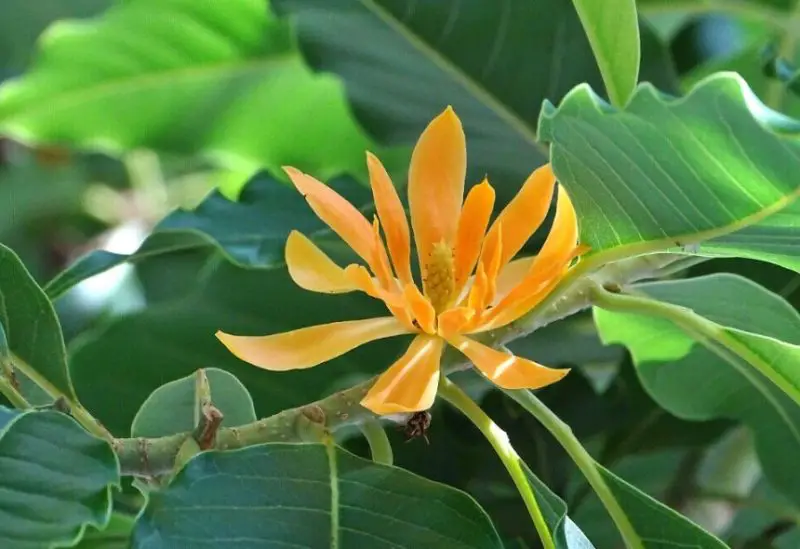
The Fragrant Himalayan Champaca is a tall, evergreen tree admired for its intensely fragrant, yellow to orange-yellow flowers. Native to South and Southeast Asia, it belongs to the magnolia family and is traditionally planted near temples and homes due to its beautiful scent. The flowers are commonly used in perfumes and religious offerings.
This tree can grow up to 50 to 80 feet tall with a narrow, upright form and glossy, dark green leaves. It prefers a warm, humid climate and thrives in rich, well-drained soil with consistent moisture. The tree blooms intermittently throughout the year in suitable climates, and the flowers emit a strong, sweet fragrance that is most potent in the evening.
Fragrant Himalayan Champaca is suitable for USDA zones 10 to 11. It is a prized ornamental tree in tropical gardens, botanical collections, and spiritual landscapes, where both its beauty and fragrance are deeply appreciated.
Golden Chain Tree (Laburnum anagyroides)
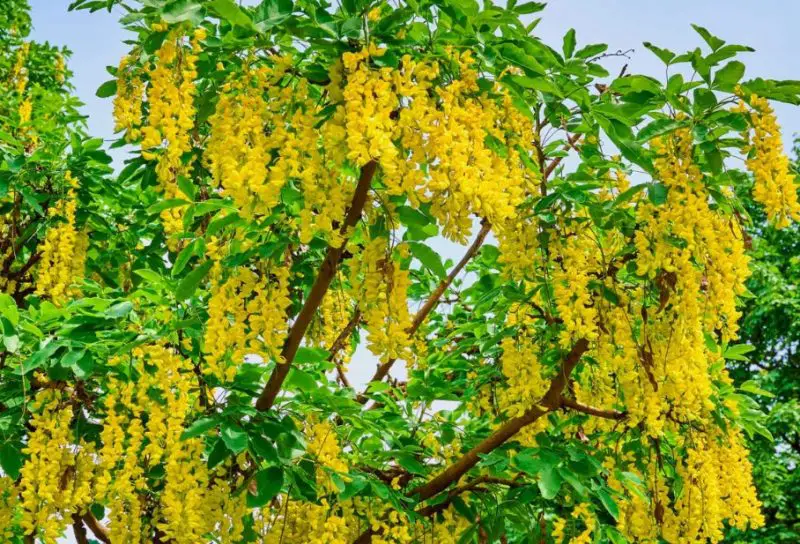
The Golden Chain Tree is a deciduous tree known for its spectacular hanging clusters of bright yellow flowers that resemble golden chains. These blooms typically appear in late spring to early summer and can reach up to 20 inches in length. Native to southern Europe, it is popular in temperate ornamental gardens.
The tree grows up to 15 to 25 feet tall with a rounded crown and smooth, green-gray bark. It prefers full sun to partial shade and grows well in well-drained, slightly alkaline soils. While beautiful, the tree is toxic if ingested, especially the seeds, and should be handled with care in family gardens.
Golden Chain Tree grows best in USDA hardiness zones 5 to 7. It is well-suited for cooler climates and often planted as a specimen tree, along walkways, or in cottage-style gardens where its graceful floral display can shine.
Yellow Elder Tree (Tecoma stans)
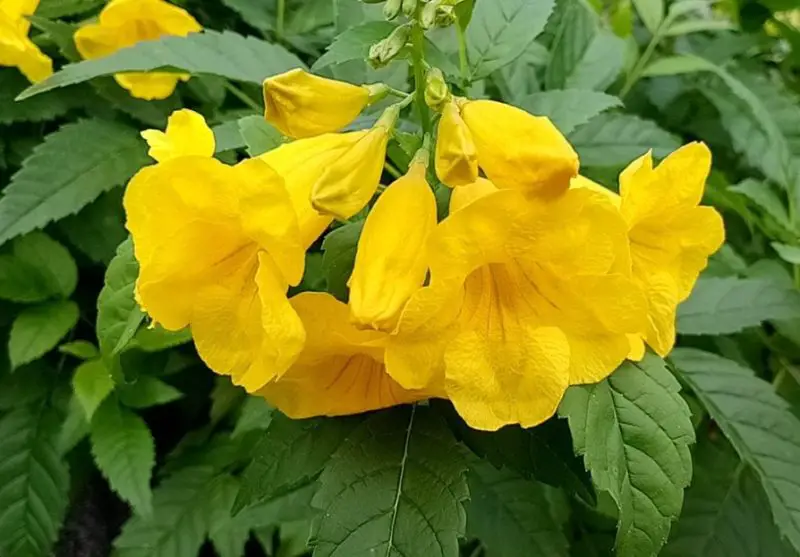
The Yellow Elder Tree, also known as Yellow Bells or Trumpetbush, is a flowering shrub or small tree known for its brilliant golden-yellow, trumpet-shaped flowers. Native to the Americas, it blooms from spring through fall and is highly attractive to hummingbirds and bees. The bright flowers create a cheerful display against its dark green foliage.
This tree usually reaches 10 to 20 feet in height and forms a spreading, rounded canopy. It thrives in full sun and well-drained soil, making it suitable for xeriscaping and low-maintenance gardens. It is drought-tolerant once established and can be pruned to maintain shape or encourage more blooms.
Yellow Elder is hardy in USDA zones 9 to 11. It is commonly used in tropical and subtropical landscapes as a flowering hedge, border plant, or ornamental tree, providing continuous color and wildlife interest throughout much of the year.
Kowhai Tree (Sophora microphylla)

The Kowhai Tree is a graceful tree native to New Zealand, celebrated for its clusters of bright yellow, pendulous flowers that appear in early spring. These blooms are a vital nectar source for native birds, including the tui and bellbird. Its name, “Kōwhai,” means “yellow” in Māori.
This deciduous or semi-evergreen tree typically grows between 20 and 40 feet tall with fine, fern-like foliage composed of small leaflets. It prefers full sun and well-drained soils, and it often grows along riverbanks and open woodlands. The tree has a somewhat twisted trunk and branches, adding to its ornamental value.
Kowhai Tree is suitable for USDA zones 9 to 10. While native to New Zealand, it adapts well to mild coastal climates and is popular in public gardens and residential landscapes for its unique shape and stunning springtime blooms.
Senna Tree (Senna spectabilis)
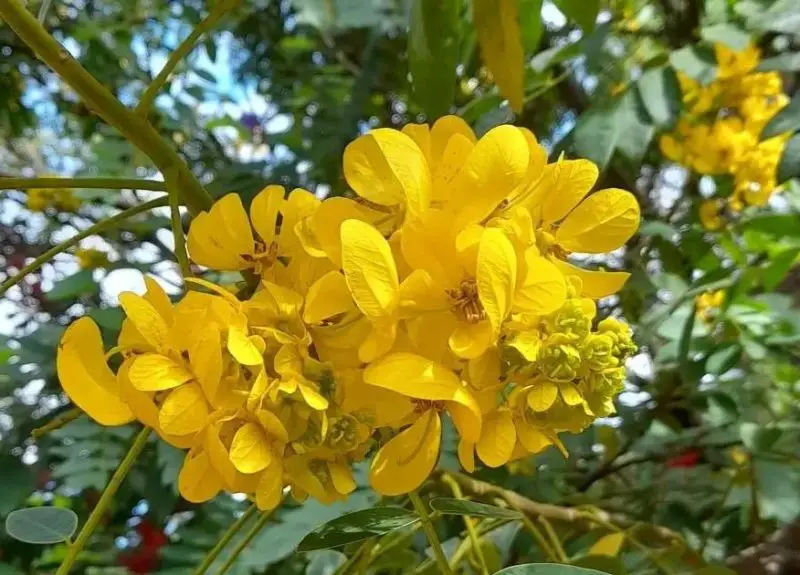
The Senna Tree is a fast-growing tropical tree prized for its profuse display of bright yellow, showy flowers that appear in large clusters. Blooming in late summer to fall, the tree is a striking sight in any garden or street planting. It is native to Central and South America and is sometimes called “Golden Wonder Tree.”
It grows quickly to a height of 25 to 40 feet and features smooth gray bark, pinnate leaves, and a broad, rounded canopy. Senna spectabilis prefers full sun and well-drained soil and tolerates a range of environmental conditions, including seasonal droughts. After flowering, it produces long, dark seed pods that hang decoratively from the branches.
This species is suitable for USDA hardiness zones 9 to 11. It is commonly used as a shade tree, ornamental focal point, or seasonal bloomer in tropical and subtropical gardens, where its golden display adds warmth and energy to the landscape.
Mexican Palo Verde (Parkinsonia aculeata)
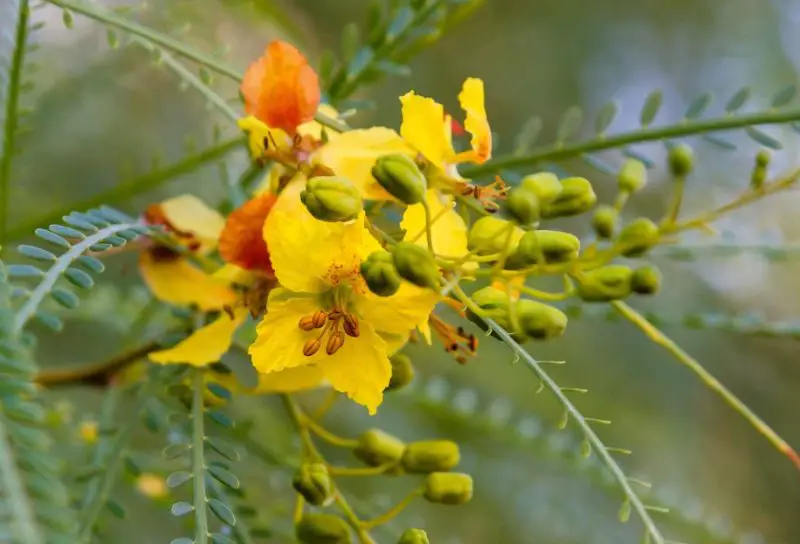
The Mexican Palo Verde is a distinctive small tree or large shrub recognized for its green bark and bright yellow flowers with an orange splash on one petal. Native to the southwestern United States and Mexico, it blooms in spring and sporadically throughout the warmer months. The name “Palo Verde” means “green stick” in Spanish, referring to its green trunk and branches, which perform photosynthesis.
This fast-growing tree typically reaches heights of 15 to 30 feet with a wide, airy canopy and drooping branches. It has small, pinnate leaves that drop in drought, allowing the tree to conserve water while relying on its green stems for energy. Its spiny branches and tolerance to dry conditions make it ideal for arid landscapes.
Mexican Palo Verde thrives in USDA hardiness zones 8 to 11. It’s a favorite in xeriscaping, desert gardens, and naturalized areas, especially where low water use is desired. The tree provides excellent wildlife habitat and erosion control in dry regions.
Jerusalem Thorn (Parkinsonia florida)
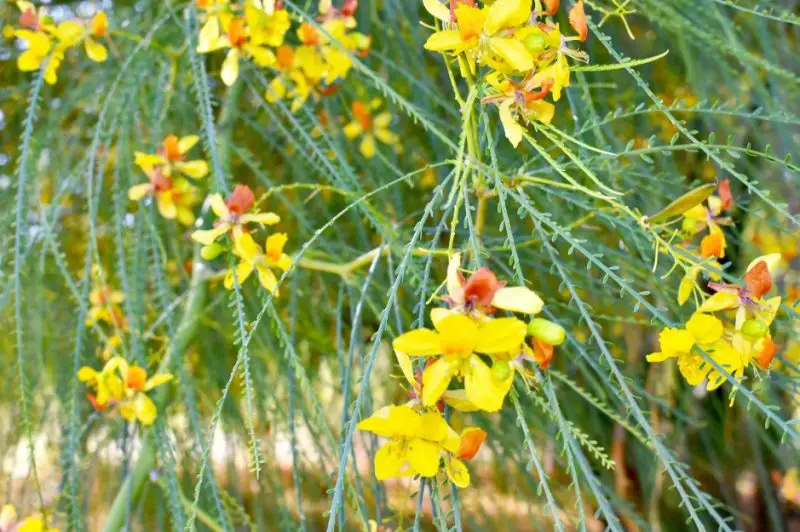
Jerusalem Thorn, also known as Blue Palo Verde, is a small desert tree native to the southwestern United States. It’s known for its striking green-blue bark and bright yellow flowers that bloom in spring, often covering the tree in a brilliant golden cloud. The flowers are small, fragrant, and highly attractive to pollinators like bees and hummingbirds.
It typically grows 15 to 25 feet tall and has a multi-trunked, vase-like shape. The tree has tiny leaves that drop during dry spells, leaving the photosynthetic branches to sustain it. This drought-hardy species thrives in sandy or rocky soils and is extremely well-suited to desert landscapes.
Jerusalem Thorn is hardy in USDA zones 8 to 10. It’s often planted in water-wise gardens, along roadsides, or in desert restoration projects. Its fast growth and low maintenance make it an excellent choice for sunny, dry environments.
Cornelian Cherry Dogwood (Cornus mas)
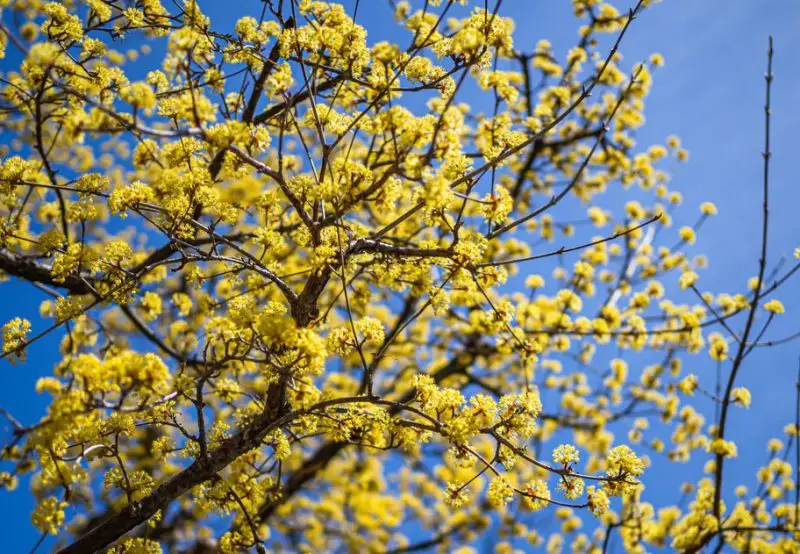
The Cornelian Cherry Dogwood is a small deciduous tree or large shrub prized for its early spring bloom of small, bright yellow flowers that appear before the leaves. Native to Europe and western Asia, it adds color to the garden when few other trees are flowering. The flowers are borne in rounded clusters, giving the tree a golden, fuzzy appearance.
This slow-growing tree reaches about 15 to 25 feet in height with a dense, spreading canopy. It has dark green, oval leaves and produces edible red fruits in late summer that resemble cherries. These fruits are often used in jams and preserves. The tree is tolerant of a wide range of soil types and can be grown in sun to partial shade.
Cornelian Cherry Dogwood is hardy in USDA zones 4 to 8. It is a great choice for hedgerows, borders, and mixed shrub plantings. Its early bloom and attractive fruit make it a valuable ornamental and wildlife plant.
Golden Currant Tree (Ribes aureum)
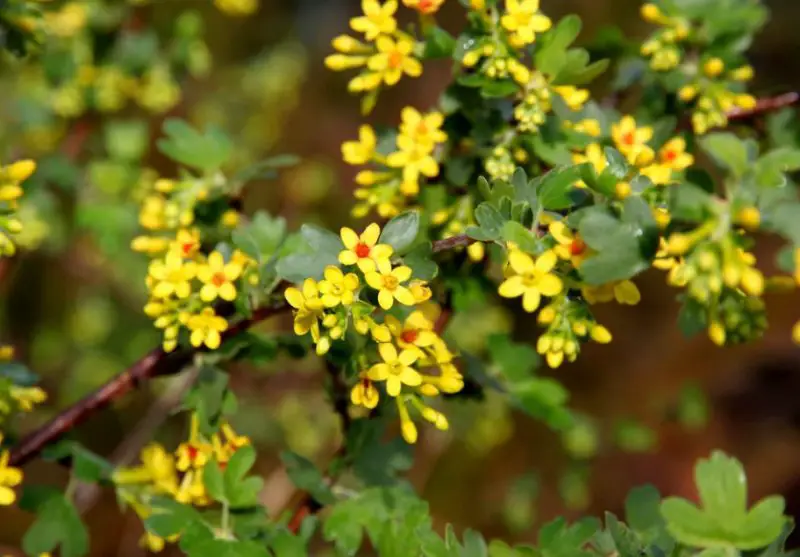
The Golden Currant is a deciduous shrub or small tree that bursts into bloom in early spring with clusters of bright yellow, tubular flowers. Native to North America, it is highly fragrant and attracts bees, butterflies, and hummingbirds. The flowers give way to small edible berries that ripen from yellow to red or black.
This plant grows between 6 to 10 feet tall and has arching branches with lobed, maple-like leaves that turn red or orange in fall. It thrives in a variety of soil types and is adaptable to full sun or partial shade. The berries are enjoyed by birds and can also be used in jellies and pies.
Golden Currant is hardy in USDA zones 4 to 8. It’s commonly planted in native gardens, hedgerows, and as a flowering accent in wildlife-friendly landscapes. Its combination of early blooms, attractive foliage, and edible fruit make it a versatile addition.
Witch Hazel (Hamamelis virginiana)
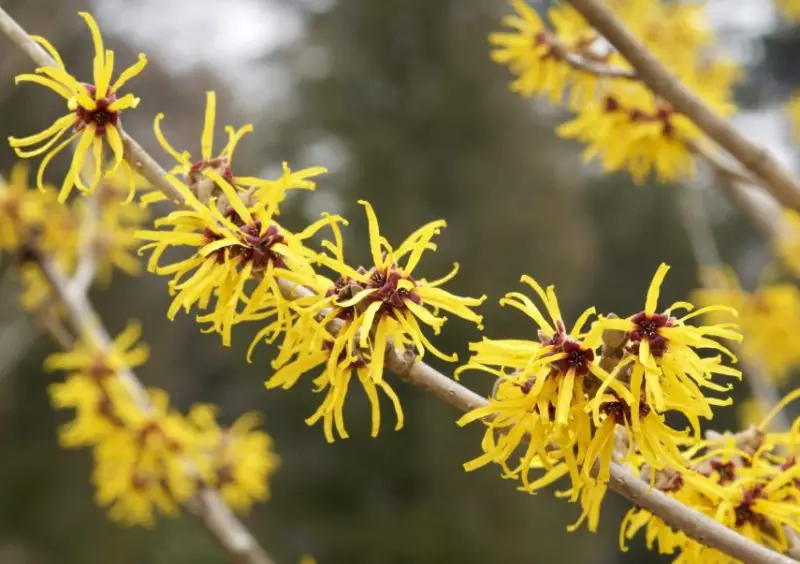
Witch Hazel is a unique, deciduous shrub or small tree best known for its spidery, yellow flowers that bloom in late fall to early winter, often after leaf drop. Native to eastern North America, it brings unexpected color to the landscape when most other plants are dormant. The flowers have ribbon-like petals and a mild, sweet fragrance.
Witch Hazel grows to about 15 to 20 feet in height and spreads equally wide. It prefers moist, well-drained soils and partial shade but can tolerate full sun. Its broad green leaves turn bright yellow in autumn before falling, complementing the unusual late-season blooms.
It thrives in USDA zones 3 to 8. Witch Hazel is often used in woodland gardens, shady borders, or near water features. In addition to its ornamental value, its bark and leaves have long been used for medicinal extracts.
Yellow Buckeye (Aesculus flava)

The Yellow Buckeye is a large deciduous tree native to the Appalachian region of the United States. It is admired for its tall spikes of pale yellow flowers that appear in mid to late spring. The tree has a strong presence in the landscape, with bold, palmately compound leaves and a stately form.
This tree can reach heights of 50 to 75 feet with a straight trunk and an oval or rounded crown. It prefers rich, moist, well-drained soils and grows best in full sun to partial shade. The tree also produces smooth brown fruits, or “buckeyes,” that are not edible but are often collected for ornamental purposes.
Yellow Buckeye is hardy in USDA zones 4 to 8. It is an excellent choice for large parks, arboretums, or spacious residential landscapes. Its spring bloom, fall color, and attractive form make it a favorite shade and specimen tree in temperate climates.
Japanese Cornel Dogwood (Cornus officinalis)
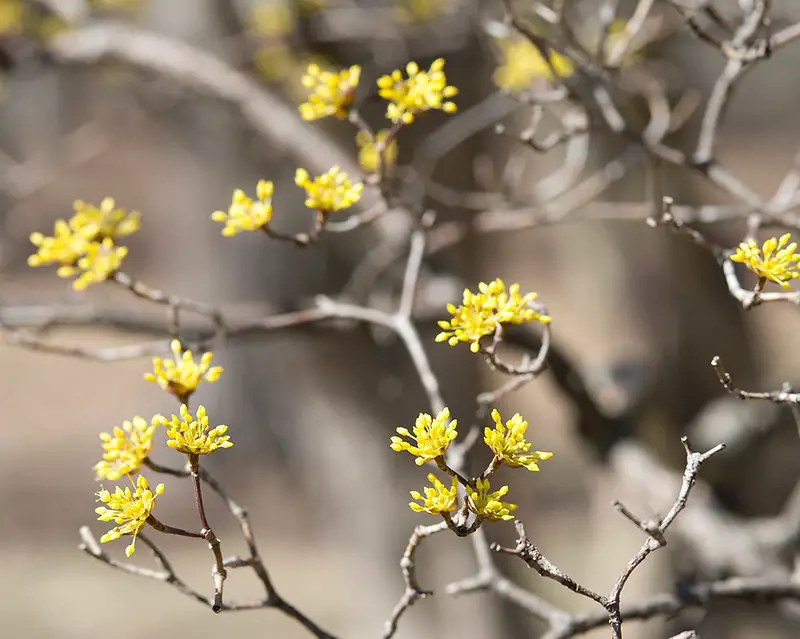
The Japanese Cornel Dogwood is a small deciduous tree or large shrub known for its early spring display of small, yellow flowers that emerge before the leaves. Native to China, Korea, and Japan, its golden blossoms appear in rounded clusters and create a cheerful display even in late winter. The flowers are followed by bright red, olive-shaped fruits.
This tree typically grows 15 to 25 feet tall with a broad, spreading canopy. It has exfoliating bark that adds year-round interest, and its dark green leaves turn reddish-purple in autumn. It thrives in full sun to partial shade and prefers moist, well-drained soils.
Japanese Cornel Dogwood is suitable for USDA hardiness zones 5 to 8. It is often used in woodland gardens, borders, or as a specimen tree. Its early bloom and colorful fruit make it a great choice for multi-seasonal interest in temperate climates.
Yellow Camellia Tree (Camellia nitidissima)
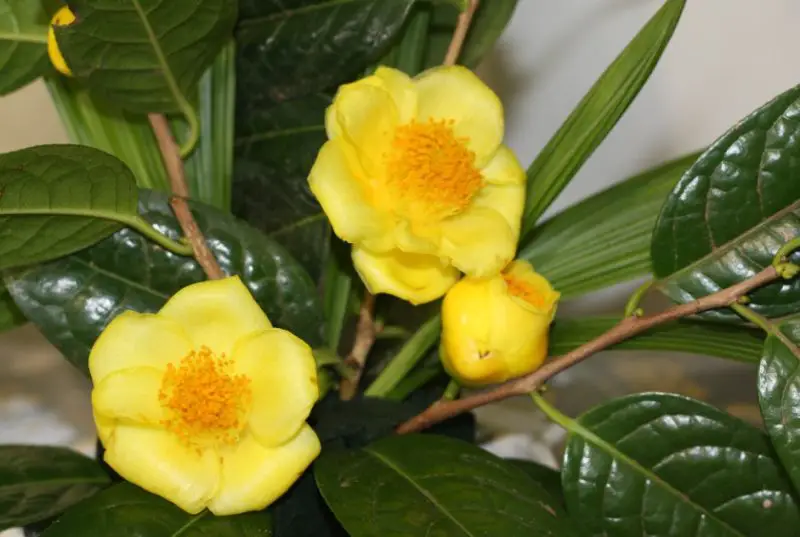
The Yellow Camellia Tree is a rare and elegant species native to southern China and Vietnam. It is prized for its golden-yellow, cup-shaped flowers, which contrast beautifully with its glossy, dark green leaves. Unlike most camellias, which bloom in pinks and reds, this species displays vibrant yellow blossoms from late winter to spring.
This slow-growing evergreen tree or large shrub reaches a mature height of 10 to 15 feet, forming a rounded, dense canopy. It prefers acidic, well-drained soil and partial shade, making it well-suited for woodland or shaded garden areas. Protection from harsh afternoon sun and wind will help preserve the delicate flowers.
Yellow Camellia is hardy in USDA zones 8 to 10. Due to its rarity and ornamental value, it is often grown in botanical gardens or as a collector’s plant. It adds elegance and unique color to camellia collections and shaded landscapes.
Amaltas Tree (Cassia fistula)
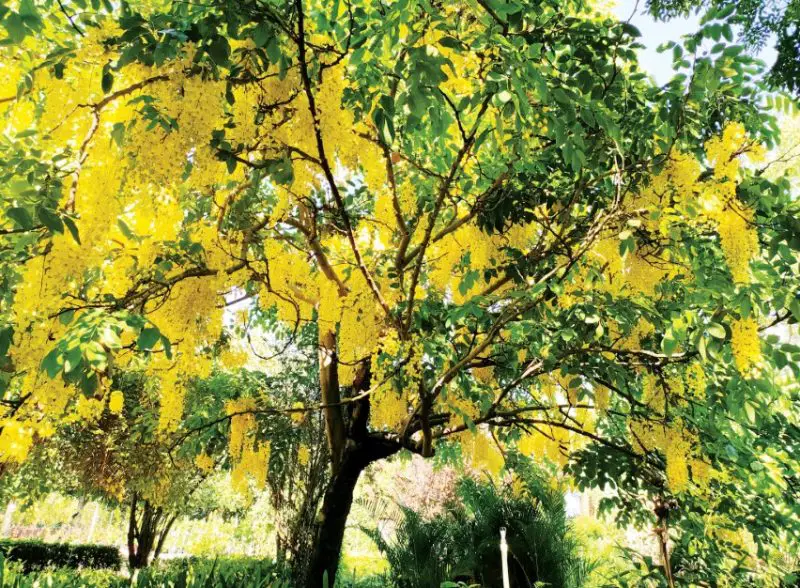
The Amaltas Tree, also known as the Indian Laburnum, is a stunning deciduous tree famed for its breathtaking display of cascading yellow flower clusters. Blooming in late spring to early summer, the long, pendulous racemes can reach up to 2 feet in length, covering the branches in golden color. It is native to the Indian subcontinent.
This tree typically grows 30 to 40 feet tall with a spreading crown and smooth gray bark. The leaves are compound and drop during the dry season, just before flowering begins. After blooming, it produces long, cylindrical seed pods that hang from the branches. The tree requires full sun and well-drained soil to thrive.
Amaltas grows best in USDA zones 9 to 11. It is often planted along roadsides, in parks, and temple gardens for its dramatic floral display. Its beauty and cultural significance make it one of the most beloved flowering trees in South Asia.
Tipu Tree (Tipuana tipu)
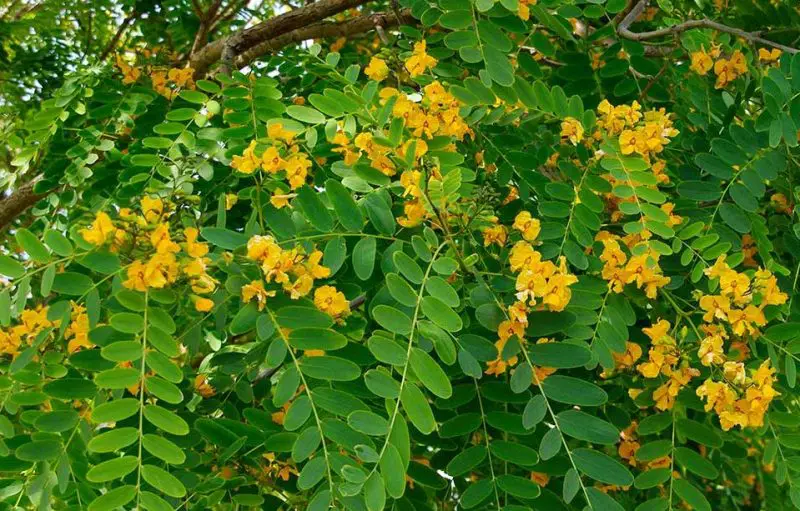
The Tipu Tree is a fast-growing, semi-deciduous tree known for its canopy of golden-yellow flowers and wide-spreading branches. Native to South America, especially Bolivia and Brazil, it is also called the Pride of Bolivia. The tree blooms in late spring to summer and produces pea-like yellow blossoms that are attractive to pollinators.
This large tree can grow 50 to 75 feet tall with an equally wide canopy, making it an excellent shade tree. Its foliage consists of feathery, pinnate leaves that provide filtered shade. Tipu trees are drought-tolerant once established and thrive in full sun and well-drained soils.
Tipuana tipu is hardy in USDA zones 9 to 11. It is often used in urban landscapes, public parks, and large gardens where shade and ornamental value are needed. The tree’s rapid growth and golden flowers make it a popular choice in warm, arid climates.
Indian Laburnum (Cassia fistula)
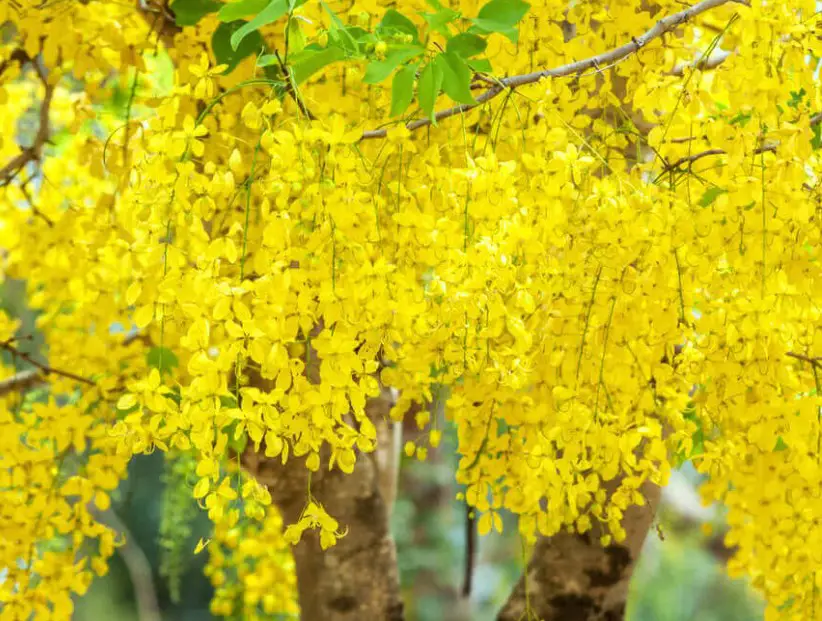
The Indian Laburnum, another name for Cassia fistula, is identical to the Amaltas Tree. It is one of the most iconic yellow-flowering trees in tropical and subtropical regions. Its vivid yellow flower chains bloom abundantly in late spring and early summer, transforming the tree into a golden cascade.
Growing to about 30 to 40 feet tall, the Indian Laburnum has a rounded, open crown and smooth bark. Its pinnate leaves fall off just before the tree bursts into bloom, leaving a striking display of flowers. The tree also produces long seed pods that dangle from the branches after flowering.
This tree is best suited for USDA zones 9 to 11 and is ideal for gardens, streets, and public parks in warm regions. Its long-lasting, vibrant blooms make it a symbol of beauty and celebration in several cultures, especially in South Asia.
Winter Hazel (Corylopsis pauciflora)

Winter Hazel is a graceful deciduous shrub or small tree that bursts into bloom in late winter to early spring with delicate, bell-shaped yellow flowers. Native to Japan and Taiwan, the pale yellow blossoms appear in drooping clusters before the leaves emerge, creating a soft, luminous effect in woodland gardens.
It grows to a modest height of 4 to 8 feet and has broad, rounded leaves that turn golden in fall. The plant prefers moist, acidic, well-drained soils and thrives in partial shade. Its early blooms are lightly fragrant and provide early nectar for pollinators.
Winter Hazel is hardy in USDA zones 5 to 8. It is often used in shaded borders, along paths, or near patios where its early flowering can be appreciated. Its compact size and elegant appearance make it an excellent choice for small garden spaces.
Chinese Flame Tree (Koelreuteria bipinnata)
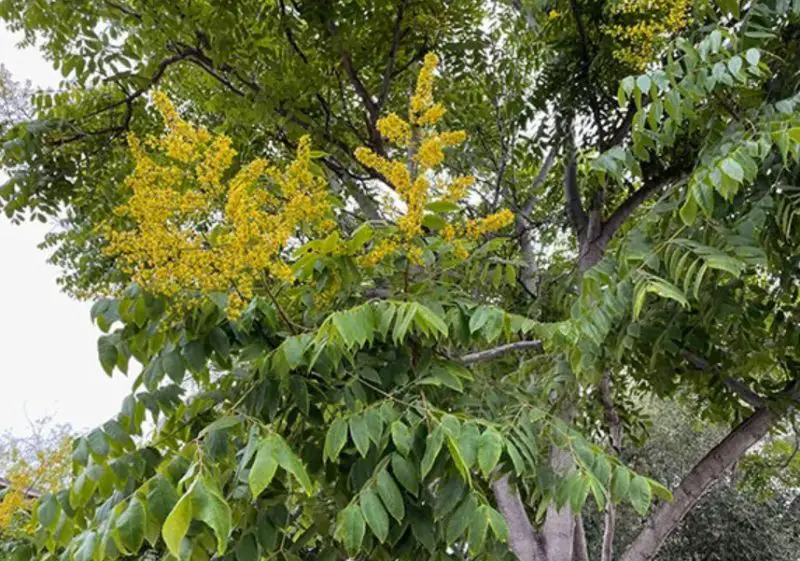
The Chinese Flame Tree is an ornamental deciduous tree known for its bright yellow flowers that bloom in late summer. Native to China and Southeast Asia, it produces large, airy panicles of yellow blossoms followed by decorative, pinkish lantern-like seed pods. These seed pods add ornamental value long after the flowers have faded.
This tree typically grows 30 to 40 feet tall with a broad, rounded crown. Its bipinnate leaves turn yellow in autumn, providing additional seasonal interest. It tolerates a range of soil conditions and prefers full sun, making it suitable for urban and residential landscapes.
The Chinese Flame Tree is hardy in USDA zones 7 to 9. It is a favorite for adding late-season color to gardens and streetscapes. Its ability to thrive in heat, drought, and urban environments makes it an excellent low-maintenance option.
Golden Rain Tree (Koelreuteria paniculata)
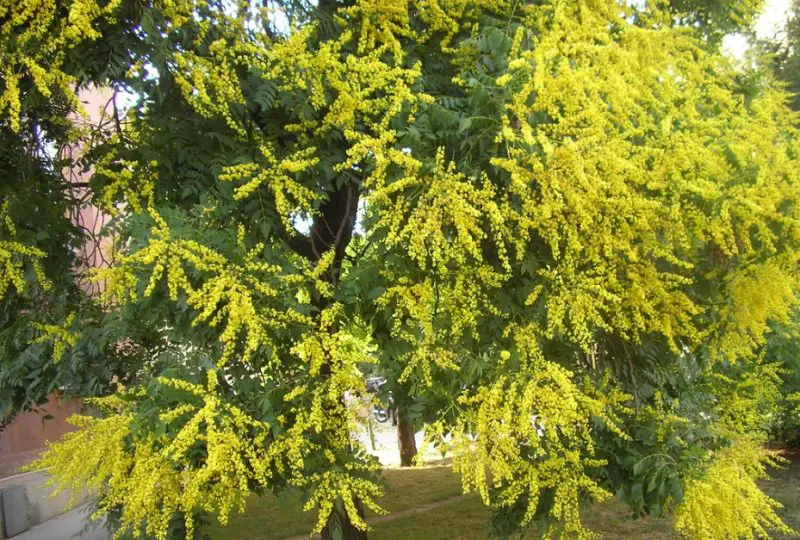
The Golden Rain Tree is a striking deciduous tree that puts on a show of bright yellow flowers in midsummer. These flowers grow in large, showy clusters and are followed by papery, lantern-shaped seed pods that add ornamental appeal through the fall. Native to East Asia, it’s often planted for its beauty and adaptability.
It typically reaches a height of 30 to 40 feet and spreads equally wide, with compound leaves that provide light shade. The tree thrives in full sun and is tolerant of drought, pollution, and poor soils, making it ideal for city planting and tough growing conditions.
Golden Rain Tree is hardy in USDA zones 5 to 9. It’s popular in parks, along streets, and in home landscapes where it provides shade, summer color, and unique fall interest. Its reliable performance and tolerance to urban stress make it a go-to choice for many landscapers.
Yellow Rhododendron (Rhododendron luteum)
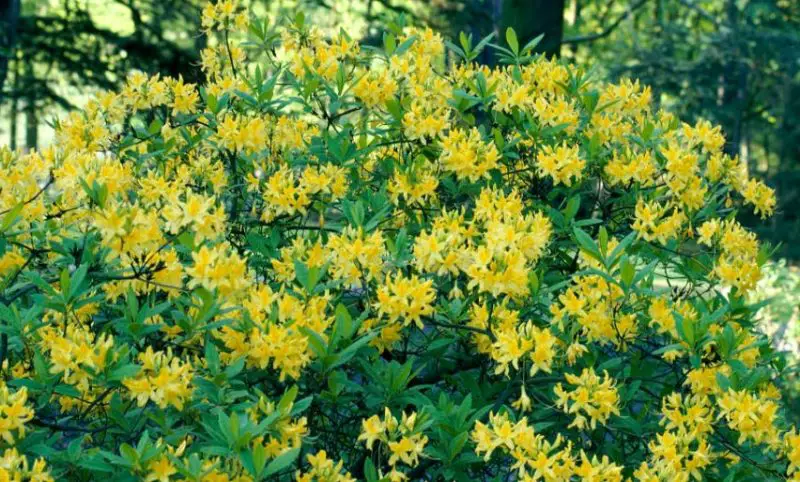
Yellow Rhododendron, also known as Azalea pontica, is a deciduous shrub or small tree known for its clusters of fragrant, bright yellow flowers that bloom in late spring. Native to Eastern Europe and parts of Western Asia, it produces tubular, funnel-shaped blossoms that are particularly attractive to butterflies and bees.
This plant grows between 6 to 10 feet tall and wide, forming a bushy shape. Its green leaves turn a vivid red-orange in autumn, giving it multi-seasonal interest. It thrives in acidic, moist, well-drained soils and prefers partial shade to filtered sunlight.
Rhododendron luteum is hardy in USDA zones 5 to 8. It’s ideal for woodland gardens, shaded borders, or naturalized settings. Its vibrant blooms and pleasant fragrance make it a standout feature in springtime landscapes.
Buttercup Magnolia (Magnolia acuminata)

The Buttercup Magnolia is a rare and beautiful deciduous tree known for its creamy yellow, tulip-shaped flowers. Native to the southeastern United States, it typically blooms in late spring to early summer. The blossoms, which resemble small magnolia cups, have a soft fragrance and are less prone to frost damage than early-blooming magnolias.
This medium to large tree can grow 30 to 50 feet tall with a pyramidal form when young, maturing to a more rounded canopy. Its dark green leaves can reach up to 10 inches long and create dense, attractive foliage throughout the growing season.
The Buttercup Magnolia is best suited for USDA zones 4 to 8. It prefers moist, well-drained soil and full sun to partial shade. It’s often planted as a specimen tree where its unique flower color and elegant shape can be fully appreciated.
Golden Shower Orchid Tree (Cassia javanica)
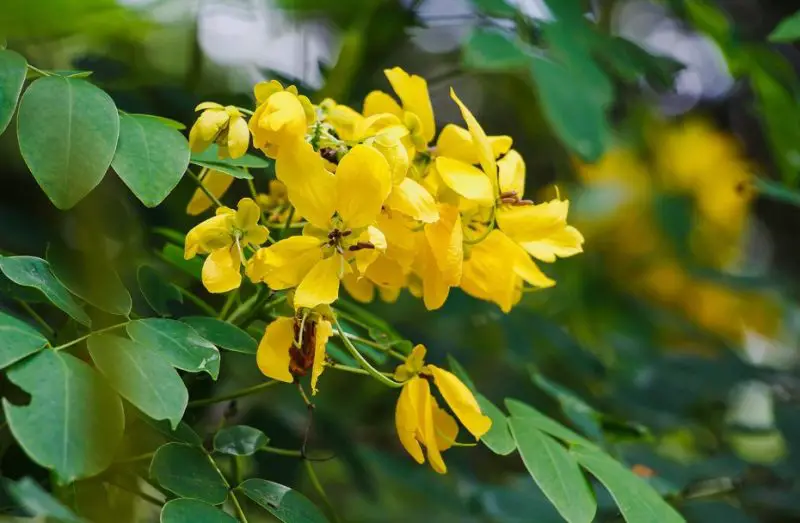
The Golden Shower Orchid Tree, also called Pink Cassia or Rainbow Shower Tree, is a showy deciduous tree admired for its clusters of yellow to pinkish-yellow flowers. Native to Southeast Asia, it blooms in spring to early summer with cascading bunches of blossoms that resemble those of Cassia fistula, though often tinged with pink hues.
It grows up to 30 to 40 feet tall and forms a rounded canopy. Its compound leaves are soft green and fall before flowering, allowing the floral display to take center stage. The tree prefers full sun and performs best in warm, humid climates with well-drained soil.
This tree is suited to USDA zones 9 to 11. It’s commonly used in tropical and subtropical landscapes for ornamental and street-side planting. Its rich floral display and graceful form make it a standout wherever it is grown.
Mimosa Tree (Yellow variety) (Albizia lebbeck)
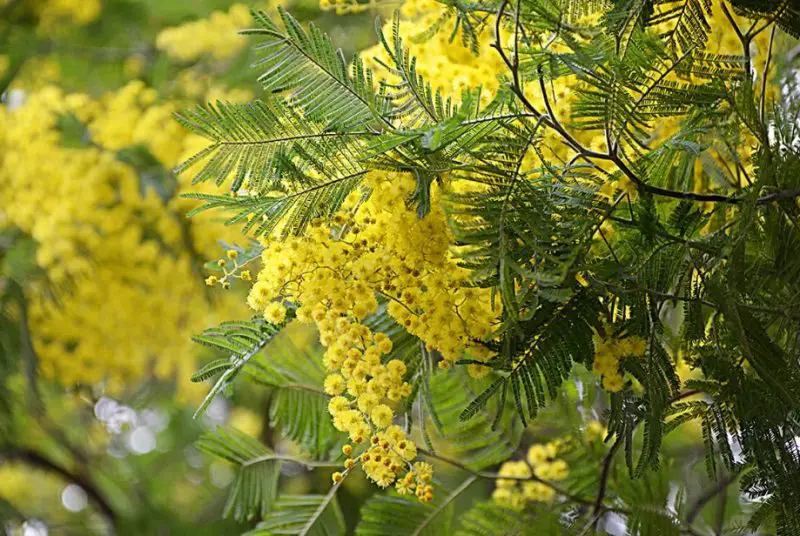
The Yellow Mimosa Tree, a yellow-flowering variant of Albizia lebbeck, is a fast-growing deciduous tree native to tropical Asia and northern Australia. It is known for its clusters of fragrant, pale yellow puffball flowers that bloom in late spring and early summer. The flowers are followed by flat, brown seed pods that rattle when shaken.
This tree reaches heights of 50 to 60 feet with a broad, spreading crown, providing excellent shade. It has feathery, bipinnate leaves that close at night or during heavy rain. The tree is adaptable to various soil types and prefers full sun for optimal flowering.
Yellow Mimosa Tree is hardy in USDA zones 9 to 11. It’s often used in tropical or semi-arid landscapes as a shade tree or ornamental feature. Its fast growth and bright, sweet-smelling flowers make it an attractive choice for both gardens and public spaces.
Yellow Bells Tree (Tecoma stans)
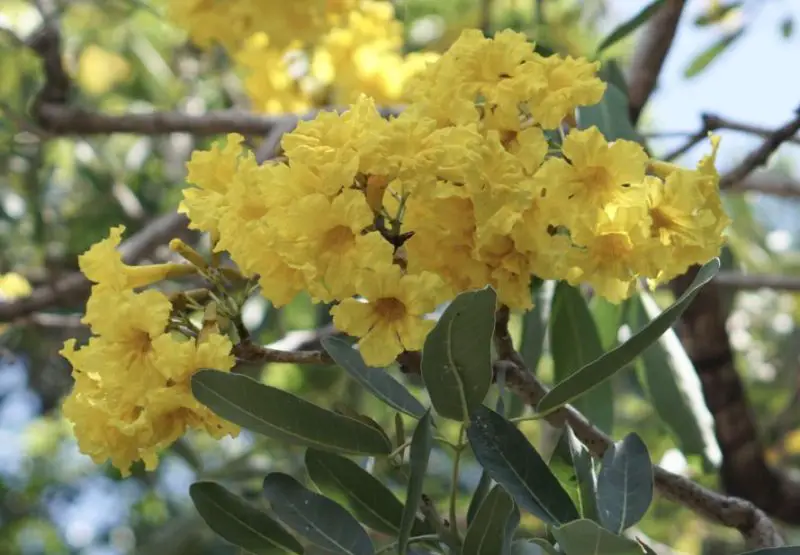
The Yellow Bells Tree, also known as Yellow Elder or Esperanza, is a vibrant deciduous shrub or small tree prized for its bright, trumpet-shaped yellow flowers. These blooms appear in clusters and persist from spring through fall, attracting hummingbirds and butterflies. Its cheerful blossoms make it a standout in any warm-climate garden.
This fast-growing plant typically reaches 6 to 20 feet in height and forms a rounded, airy canopy. Its glossy, dark green leaves provide a nice contrast to the brilliant flowers. Tecoma stans prefers full sun and thrives in well-drained soil, tolerating drought and poor soils once established.
Yellow Bells Tree is hardy in USDA zones 8 to 11. It is ideal for xeriscaping, tropical borders, and patio containers. Thanks to its low maintenance needs and long blooming period, it’s a popular ornamental choice across the southern United States and Central America.
Canary Tree (Centrolobium ochroxylum)

The Canary Tree is a striking tropical tree known for its golden-yellow, pea-like flowers that bloom in large clusters. Native to Central and South America, this legume tree lights up the landscape in late spring or summer with its vivid floral display. The flowers are followed by winged seed pods that add seasonal interest.
It grows up to 40 to 60 feet tall with a symmetrical canopy and a straight trunk. The tree’s compound leaves are lush green and contribute to its ornamental appeal. It prefers warm climates, full sun exposure, and moist but well-drained soil.
The Canary Tree is best suited for USDA zones 10 to 11. It’s often used in tropical landscaping, avenue planting, and reforestation projects. Its beauty and ability to fix nitrogen in the soil make it both attractive and ecologically valuable.
African Tulip Tree (Yellow cultivar) (Spathodea campanulata ‘Aurea’)

The yellow cultivar of the African Tulip Tree, known as Spathodea campanulata ‘Aurea’, is a rare version of the typically red-orange flowering species. Its large, tulip-shaped golden flowers appear in clusters at the ends of branches, blooming from spring to summer. The blossoms are not only eye-catching but also nectar-rich, attracting pollinators.
This fast-growing tropical tree can reach 40 to 60 feet tall and forms a dense, rounded canopy. Its glossy green leaves are pinnate and give the tree a lush, exotic appearance. It grows best in full sun with consistently moist, well-drained soil.
The Yellow African Tulip Tree thrives in USDA zones 10 to 11. It is best suited for tropical and subtropical climates and is commonly planted as a specimen or street tree. Its unique flower color makes it a prized collector’s item among rare tree enthusiasts.
Yellow Bauhinia Tree (Bauhinia tomentosa)
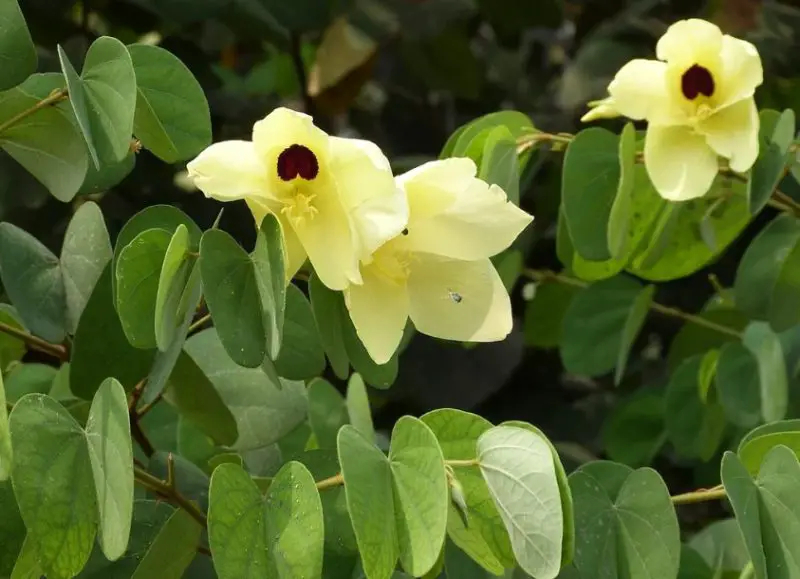
Bauhinia tomentosa, commonly called Yellow Bauhinia or Yellow Bell Orchid Tree, is a small ornamental tree known for its delicate, lemon-yellow flowers with a dark maroon spot at the base of the upper petal. These charming blooms appear sporadically throughout the growing season, giving the tree a dainty and graceful appearance.
Typically reaching 6 to 12 feet tall, this small tree or large shrub has soft, gray-green, two-lobed leaves that resemble butterfly wings. It performs best in full sun and well-drained soil, tolerating dry conditions once established. Its compact size makes it suitable for small gardens or container planting.
Yellow Bauhinia Tree is hardy in USDA zones 9 to 11. Native to parts of Africa and Asia, it is often planted for ornamental use in warm, dry climates. The combination of soft foliage and gentle yellow blossoms makes it a lovely choice for tropical or subtropical landscapes.
Indian Senna Tree (Senna alexandrina)
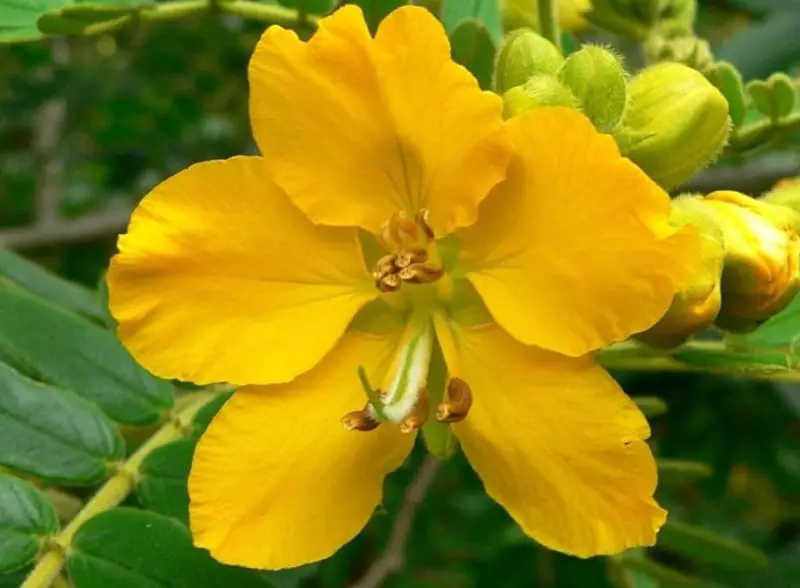
The Indian Senna Tree, or Senna alexandrina, is a flowering shrub or small tree famous for both its medicinal uses and its vibrant yellow blooms. The flowers appear in upright clusters and bloom profusely during the warmer months, giving a lively appearance to the landscape.
This plant typically reaches 3 to 6 feet in height but can grow taller under ideal conditions. It has pinnate leaves and smooth green stems, with flowers followed by flat, narrow seed pods. Senna thrives in full sun and dry, sandy soils, making it suitable for arid or semi-arid regions.
Indian Senna is hardy in USDA zones 9 to 11. Besides its ornamental value, it’s widely cultivated for its leaves and pods, which are used in herbal medicine as a natural laxative. It fits well into medicinal gardens, desert landscapes, and low-water-use settings.
Yellow Cotton Tree (Cochlospermum religiosum)
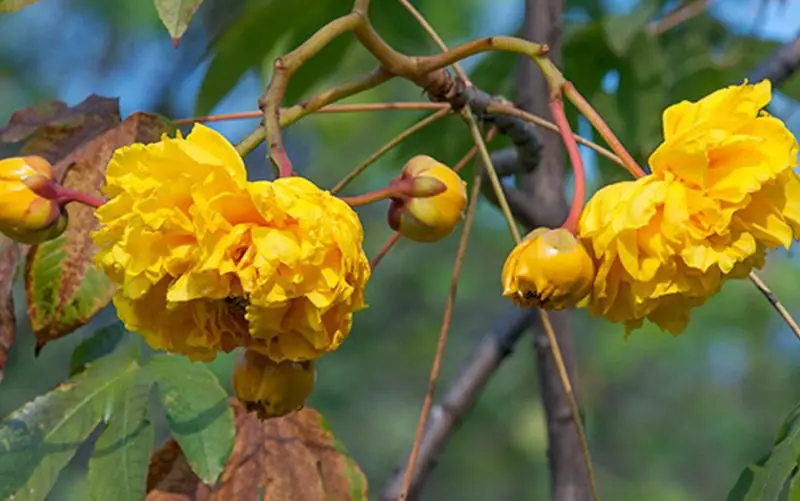
The Yellow Cotton Tree, also known as Buttercup Tree or Cochlospermum religiosum, produces large, bright yellow flowers that resemble poppies or buttercups. These flowers bloom in early spring, often before the leaves appear, creating a dazzling floral display against bare branches.
This deciduous tree grows 20 to 40 feet tall and features a rough bark and sparse, palmately lobed leaves. Native to the Indian subcontinent and Southeast Asia, it prefers full sun and well-drained soil, thriving best in tropical and subtropical climates.
The Yellow Cotton Tree is hardy in USDA zones 10 to 11. It is highly valued in temple gardens and public spaces across Asia due to its sacred significance and striking beauty. Its showy blooms and dry-season flowering make it a spectacular ornamental addition.
Yellow Tabebuia (Handroanthus chrysotrichus)
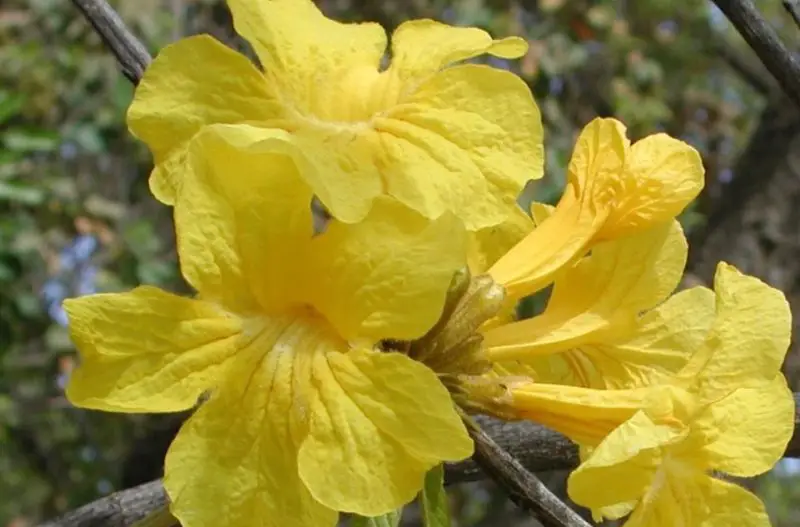
Yellow Tabebuia, also known as Golden Trumpet Tree, is celebrated for its breathtaking yellow trumpet-shaped flowers that bloom in early spring. The blossoms typically emerge before the foliage, creating a dramatic and colorful display that brightens landscapes in tropical and subtropical areas.
This medium-sized deciduous tree usually grows between 20 to 40 feet tall, with a rounded canopy and slender trunk. Its bark is gray and rough, while the compound leaves are dark green and palmately arranged. Yellow Tabebuia thrives in full sun and well-drained soils and is moderately drought-tolerant once established.
It is hardy in USDA zones 9 to 11. Popular in urban landscaping, parks, and avenues, the Yellow Tabebuia is prized for its ornamental value and relatively low maintenance. It attracts pollinators like bees and hummingbirds, enhancing biodiversity in garden settings.
West Indian Locust Tree (Yellow flowers) (Hymenaea courbaril)
The West Indian Locust Tree, or Hymenaea courbaril, is a large tropical tree that occasionally displays yellow-green flowers with a subtle beauty. Though its flowers are not as showy as some other species, they offer a sweet fragrance and serve as an important source of nectar for pollinators.
This impressive tree can grow up to 100 feet tall with a broad, spreading canopy and thick, deeply furrowed bark. It has glossy, dark green compound leaves and is well known for producing a hard, durable wood and edible fruit pods. It prefers full sun and rich, well-drained soils.
The West Indian Locust is hardy in USDA zones 10 to 11. Native to Central and South America and parts of the Caribbean, it is valued for shade, timber, and ecological benefits. Its occasional yellow blooms are a pleasant addition to its more practical landscape uses.
Golden Butterfly Tree (Bauhinia forficata)
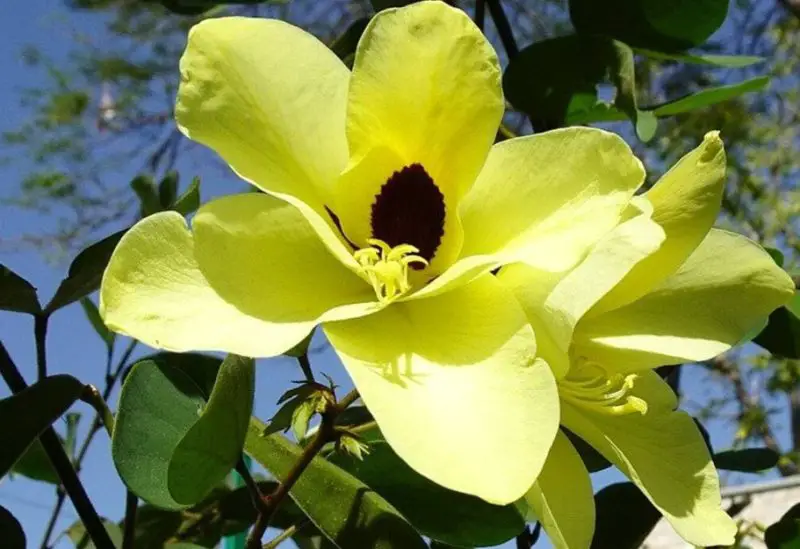
The Golden Butterfly Tree, commonly known as Brazilian Orchid Tree, is admired for its elegant yellow flowers that resemble butterflies in flight. These blooms have a delicate fragrance and appear in small clusters, contributing to the tree’s graceful, airy aesthetic.
It generally grows 15 to 25 feet tall and forms a spreading, umbrella-like canopy. Its bilobed leaves are reminiscent of butterfly wings and remain a soft green throughout the year. This semi-deciduous tree prefers full sun to partial shade and does best in well-drained soil.
The Golden Butterfly Tree is suited for USDA zones 9 to 11. Native to South America, it is often planted as an ornamental in gardens, along streets, and in parks. In addition to its visual appeal, it supports pollinators and adds a tropical flair to landscapes.
Bahama Senna Tree (Senna mexicana)
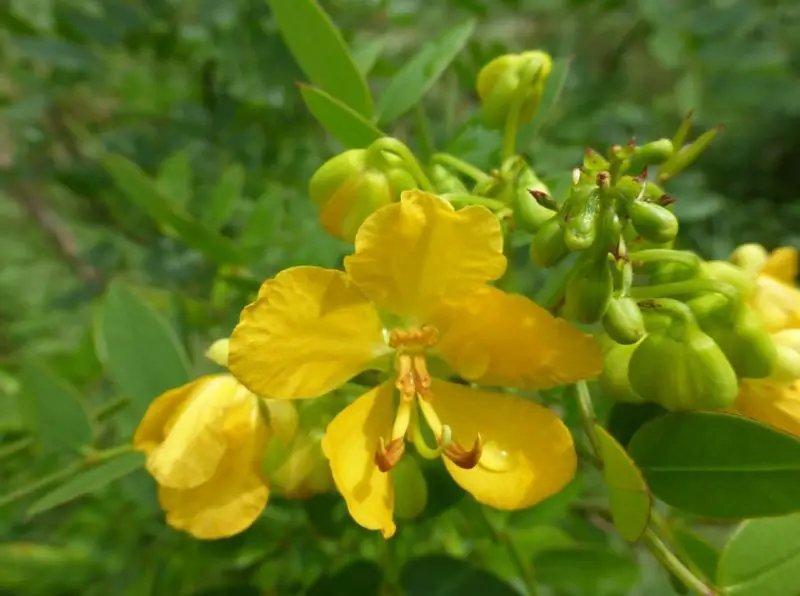
The Bahama Senna Tree, also called Senna mexicana, is a small, sun-loving tree known for its cheerful yellow flowers that bloom prolifically throughout the year in warm climates. These bright, five-petaled flowers attract bees and butterflies and bring a splash of golden color to dry landscapes.
This fast-growing shrub or small tree typically reaches 6 to 15 feet in height, forming an open, spreading canopy. It has pinnate leaves with several small, oval leaflets and thrives in sandy, well-drained soils with full sun exposure. It is drought-tolerant and ideal for xeriscaping.
Bahama Senna Tree is hardy in USDA zones 9 to 11. Native to Florida, the Caribbean, and Mexico, it is commonly used in native gardens, pollinator habitats, and coastal landscapes. Its low maintenance and long blooming season make it a popular ornamental plant.
Candle Tree (Senna alata)

The Candle Tree, also known as Candlestick Senna or Empress Candle Plant, is famous for its unique, upright yellow flower spikes that resemble candles. These flower spikes can grow up to 12 inches long and bloom from late summer through fall, adding architectural interest to the landscape.
It typically grows 6 to 15 feet tall and has large, tropical-looking pinnate leaves that close at night. The tree thrives in full sun and moist, well-drained soil, and can be used as a flowering shrub or small ornamental tree. Its fast growth and eye-catching blooms make it a standout in any garden.
Candle Tree is suitable for USDA zones 9 to 11. It is native to tropical regions of the Americas and Africa and is often planted in butterfly gardens due to its attraction to pollinators. Its bold flowers and lush foliage bring a dramatic tropical touch to warm-climate gardens.
Silver Wattle Tree (Acacia dealbata)

The Silver Wattle Tree is an elegant species known for its feathery, silvery-blue foliage and fluffy golden-yellow flower clusters that appear in late winter to early spring. These fragrant blooms are highly attractive to bees and offer a burst of color when few other trees are flowering.
It typically grows between 20 to 50 feet tall with a graceful, upright growth habit. The finely divided leaves give the tree a soft texture, while its smooth gray bark adds contrast. It thrives in full sun and prefers well-drained, slightly acidic soils.
Silver Wattle is hardy in USDA zones 9 to 11. Native to southeastern Australia, it is widely cultivated as an ornamental tree in Mediterranean and subtropical climates. Besides its beauty, it is valued for erosion control and soil improvement due to its nitrogen-fixing ability.
Sweet Acacia (Vachellia farnesiana)
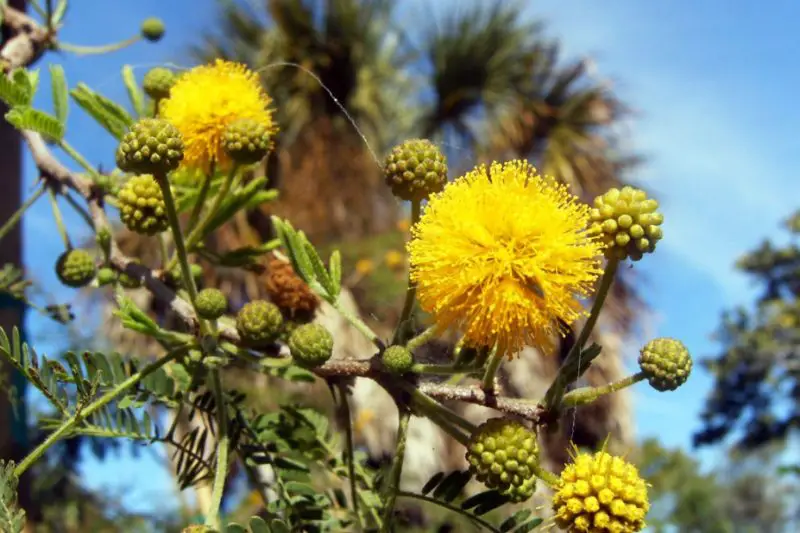
Sweet Acacia is a small, thorny tree celebrated for its ball-shaped golden-yellow flowers that emit a rich, sweet fragrance, especially in the spring. The blooms are clustered and highly attractive to pollinators, including bees and butterflies, making it a great addition to wildlife-friendly gardens.
This hardy tree grows between 15 and 25 feet tall and features fine, feathery bipinnate leaves, as well as sharp thorns along its branches. It thrives in full sun and tolerates drought and poor soil conditions, making it well-suited for arid and semi-arid landscapes.
Sweet Acacia is hardy in USDA zones 8 to 11. Native to the Americas, it is often planted in xeriscapes, along highways, and in desert-themed gardens. Its resilience and ornamental appeal make it a popular choice in southern and southwestern climates.
Golden Cassia Tree (Cassia siamea)

The Golden Cassia Tree, also known as Siamese Cassia, produces large clusters of bright yellow flowers that bloom profusely during the warm season. These flowers are arranged in elongated racemes and offer a showy contrast against the tree’s dark green foliage.
It typically grows between 20 and 40 feet tall with a spreading canopy. Its compound leaves are glossy and pinnate, and the tree is semi-evergreen in tropical climates. It prefers full sun and moderately moist, well-drained soil but can tolerate dry spells once established.
Golden Cassia Tree is suited to USDA zones 10 to 11. Native to Southeast Asia, it is often used in tropical and subtropical landscapes for ornamental purposes and street planting. Its fast growth and generous flowering period make it a striking addition to sunny areas.
Senna Tree (Popcorn Cassia) (Senna didymobotrya)

The Popcorn Cassia, or Senna didymobotrya, is well-known for its bright yellow flower spikes and a curious scent resembling buttered popcorn. The upright blooms appear in dense clusters and contrast beautifully with the dark, almost black buds that precede them.
It grows as a shrub or small tree, reaching heights of 6 to 12 feet. The leaves are soft, pinnate, and emit the same popcorn-like aroma when crushed. This tropical plant flourishes in full sun and moist, fertile soil and benefits from regular watering and pruning.
Popcorn Cassia thrives in USDA zones 9 to 11. Native to tropical Africa, it is used as an ornamental plant in gardens, patios, and butterfly gardens. Its unique scent and vibrant appearance make it a favorite for sensory and educational landscapes.
Yellow Jasmine Tree (Jasminum humile)
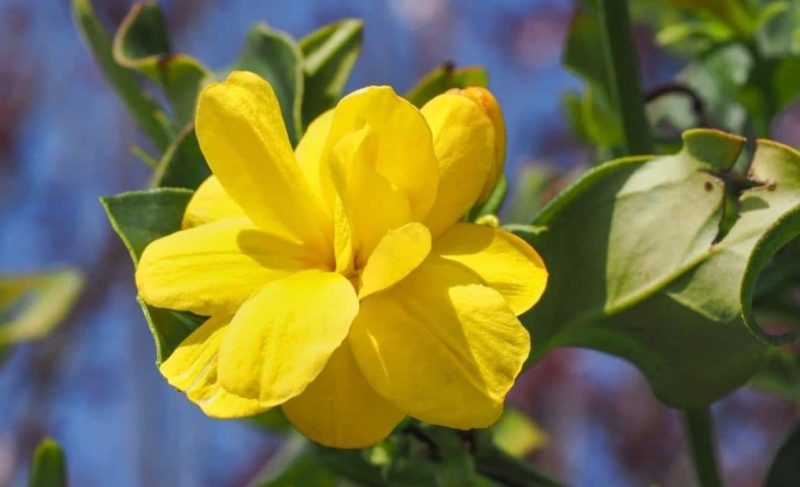
Yellow Jasmine, or Jasminum humile, is a small tree or sprawling shrub noted for its cheerful yellow, star-shaped flowers and sweet, delicate fragrance. The blossoms appear in clusters from spring to fall and brighten any garden space with their vivid color.
It usually grows to a height of 6 to 10 feet, either as a compact shrub or a small tree if pruned accordingly. The foliage is dark green, semi-evergreen, and lance-shaped. It prefers full sun to partial shade and thrives in well-drained soil with moderate moisture.
Yellow Jasmine is hardy in USDA zones 7 to 10. Native to the Himalayas and parts of China, it’s popular in cottage gardens, mixed borders, and as a foundation planting. Its long blooming season and scented flowers make it a charming and versatile ornamental.
Palo Brea Tree (Parkinsonia praecox)
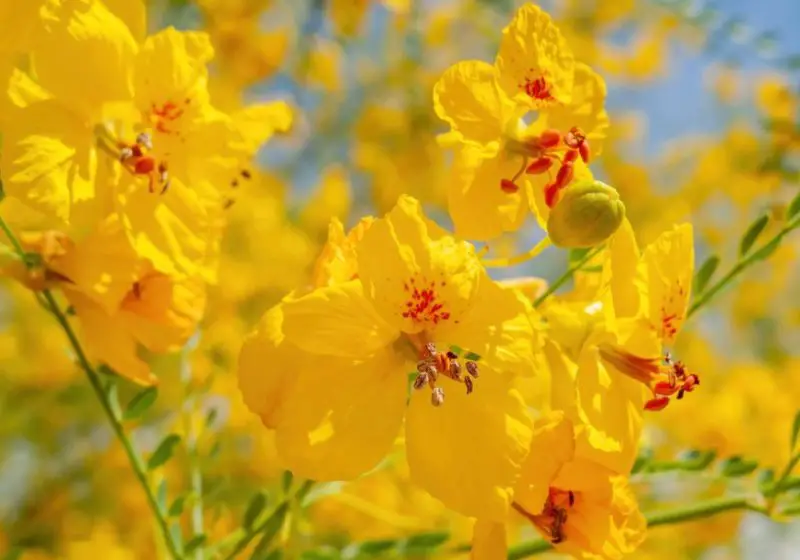
The Palo Brea Tree is a unique, desert-adapted tree recognized for its smooth, green bark and clusters of bright yellow flowers that bloom in late spring to early summer. These flowers are small but plentiful, attracting pollinators and adding seasonal beauty to arid landscapes.
It grows up to 20 to 30 feet tall and has a distinctive, sculptural form with twisting branches and airy foliage composed of tiny leaflets. This drought-tolerant species thrives in full sun and sandy or rocky soils, making it ideal for xeriscaping and low-water gardens.
Palo Brea is hardy in USDA zones 9 to 11. Native to Mexico and the southwestern United States, it’s prized for its ornamental bark, resistance to drought, and ability to add structural interest to desert landscapes. It pairs well with succulents and other drought-resistant plants.
Yellow Peony Tree (Paeonia ludlowii)

The Yellow Peony Tree is a rare and elegant species that produces large, golden-yellow, bowl-shaped flowers in late spring to early summer. Each bloom is lightly fragrant and stands atop strong stems, making them a standout in any flowering garden.
It typically grows between 4 and 6 feet tall but can occasionally reach up to 10 feet. The foliage is deeply lobed and dark green, creating a lush backdrop for its vibrant blooms. It prefers full sun to partial shade and well-drained, fertile soil that remains evenly moist.
Yellow Peony Tree is suited to USDA zones 6 to 8. Native to Tibet, it is valued for its ornamental flowers and is often featured in specialty gardens and peony collections. It is a long-lived plant, thriving for decades with minimal care once established.
Ylang-Ylang Tree (Yellow flowers) (Cananga odorata)
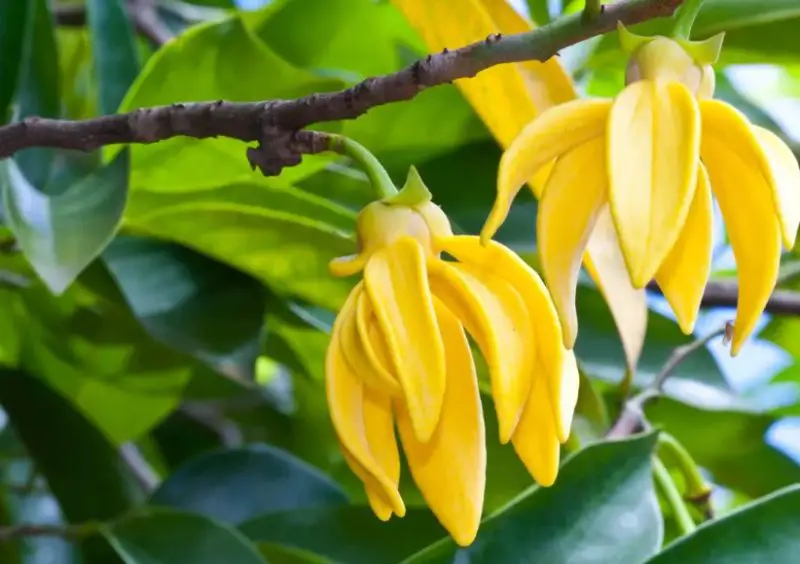
The Ylang-Ylang Tree is best known for its uniquely shaped yellow flowers, which emit a powerful, sweet fragrance used in perfumes and essential oils. The long, twisted petals are pale green when young, maturing into a rich yellow color as they age.
This tropical evergreen tree can grow up to 40 to 60 feet tall in its natural habitat but is often maintained at smaller sizes in cultivation. It has glossy green leaves and thrives in warm, humid climates with full sun to partial shade and well-drained soil.
Ylang-Ylang is suited to USDA zones 10 to 12. Native to Southeast Asia and the South Pacific, it is often grown in tropical gardens, near patios, or in spa landscapes for its scent. Regular pruning encourages bushier growth and more prolific flowering.
Copperpod Tree (Peltophorum dubium)
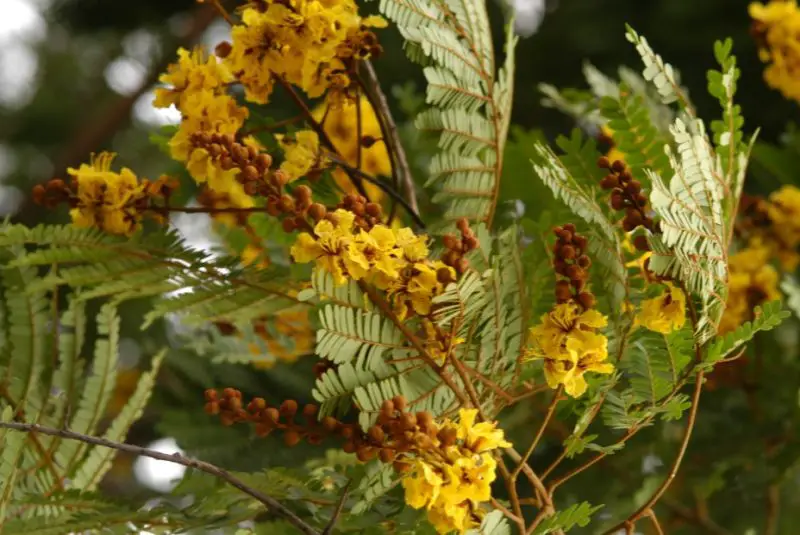
The Copperpod Tree, also known as Yellow Flame Tree in some regions, bursts into bloom with vibrant yellow flowers that form large, cascading clusters. The flowers have a slight ruffled appearance and contrast beautifully with the tree’s fern-like foliage.
This fast-growing deciduous tree typically reaches 30 to 50 feet in height and spreads widely, making it an excellent shade tree. It prefers full sun and tolerates a variety of soil types, including sandy and loamy soils.
Copperpod is hardy in USDA zones 10 to 11. Native to South America, it’s commonly planted along streets and in parks due to its ornamental beauty and ability to grow quickly. It is particularly striking when planted in rows or used as a focal point in large landscapes.
Golden Vachellia (Vachellia xanthophloea)
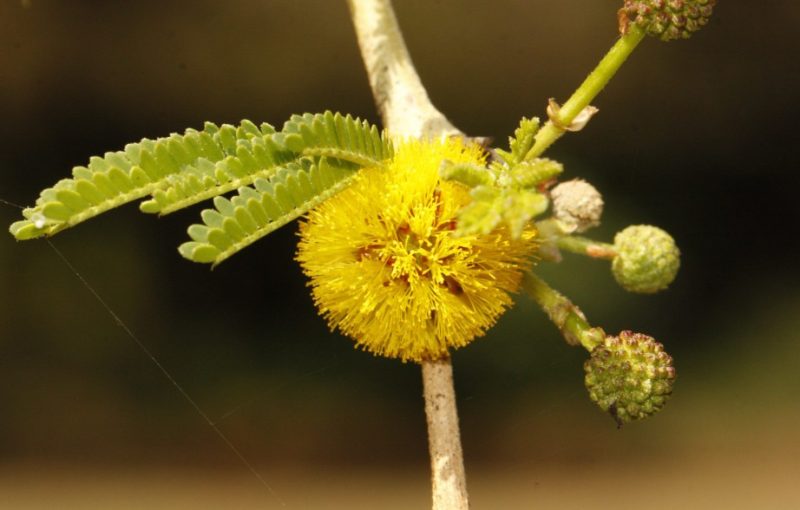
Golden Vachellia, also known as the Fever Tree, features bright yellow puffball flowers and striking, yellow-green bark that glows in the sunlight. The blooms are small but abundant, appearing in clusters and providing nectar for bees and butterflies.
This deciduous tree grows up to 40 to 60 feet tall and is recognized for its open, airy canopy and thorny branches. It thrives in full sun and prefers moist but well-drained soils, although it can tolerate periods of drought once established.
Golden Vachellia is hardy in USDA zones 9 to 11. Native to eastern and southern Africa, it is often planted for ornamental purposes in warm climates and wetland restoration projects. Its unique bark and vibrant flowers make it a standout in any landscape.
Siberian Peashrub Tree (Caragana arborescens)

The Siberian Peashrub is a hardy, deciduous shrub or small tree known for its bright yellow, pea-like flowers that bloom in late spring. These flowers are followed by slender seed pods that resemble small peas, giving the plant its common name.
It usually grows 10 to 20 feet tall and features fine, feathery foliage that gives it a soft texture. This cold-tolerant tree thrives in full sun and adapts well to poor soils, including sandy and alkaline conditions. It is drought-tolerant once established.
Siberian Peashrub is suited to USDA zones 2 to 7. Native to Siberia and parts of northern Asia, it is widely used as a windbreak, hedge, or erosion-control plant. Its extreme cold hardiness and ornamental flowers make it valuable in northern climates.
Golden Trumpet Tree (Handroanthus albus)
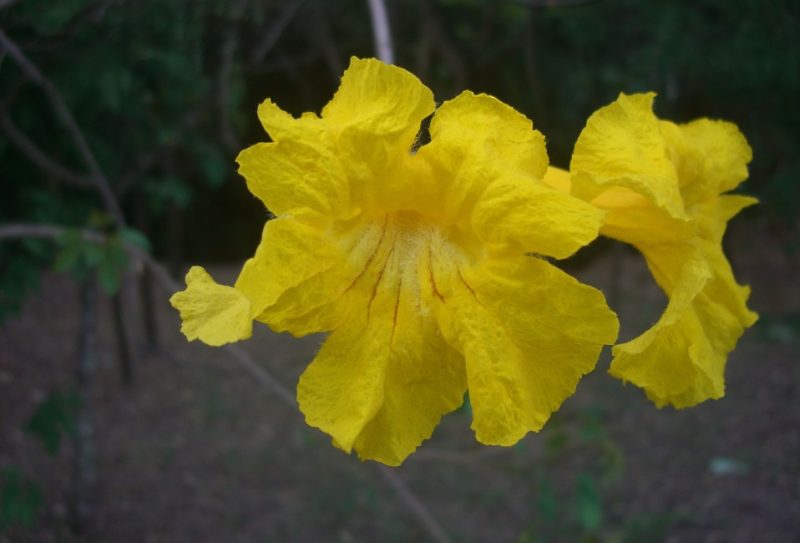
The Golden Trumpet Tree produces stunning trumpet-shaped yellow flowers that bloom profusely in spring, often before the leaves emerge. These blossoms create a striking golden display that makes the tree a highlight in any garden or urban setting.
It typically grows 20 to 30 feet tall and has a rounded, symmetrical crown. The bark is gray and furrowed, and the leaves are palmately compound. This tree thrives in full sun and well-drained soil and is tolerant of drought once mature.
Golden Trumpet Tree is hardy in USDA zones 9 to 11. Native to South America, particularly Brazil, it is commonly planted in tropical and subtropical regions for its showy blooms and moderate size. It is often used as a specimen or street tree.
Yellow Moringa Tree (Moringa drouhardii)

Yellow Moringa is a rare species of Moringa with pale yellow flowers and an upright, succulent trunk that stores water. The flowers are small and fragrant, blooming in loose clusters and often attracting pollinators such as bees and butterflies.
This drought-tolerant tree can reach heights of 20 to 30 feet and features a thick, bottle-shaped trunk and sparse branches. It prefers full sun and dry, sandy soil. While similar in structure to Moringa oleifera, it is less commonly cultivated.
Yellow Moringa is suited to USDA zones 10 to 12. Native to Madagascar, it is used in arid landscapes and restoration projects. Though not as widely used for culinary purposes, it offers ecological benefits and visual interest in desert gardens.
Yellow Tamarind Tree (Senna surattensis)
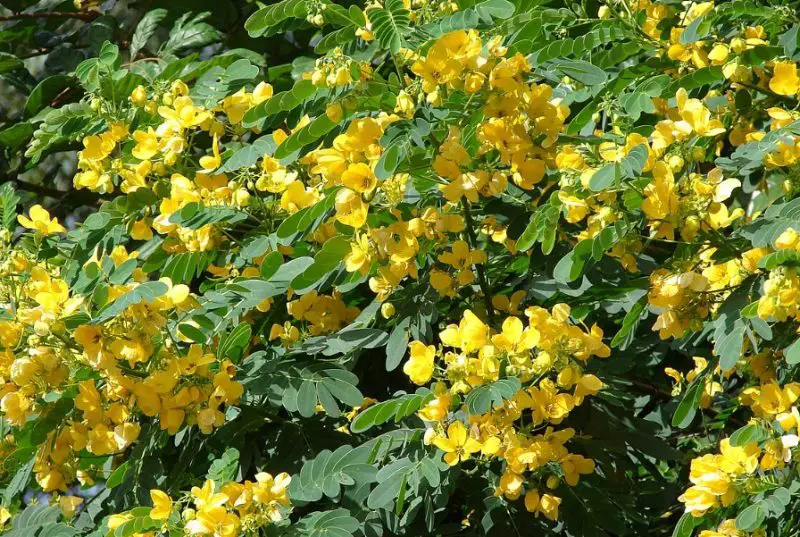
The Yellow Tamarind Tree, or Senna surattensis, is an evergreen or semi-deciduous tree with abundant yellow flowers that bloom in clusters throughout the year in tropical climates. The blooms are bright, rounded, and appear above glossy green foliage.
It grows up to 10 to 20 feet tall with a broad, spreading crown. The leaves are pinnate and slightly drooping, giving the tree a graceful silhouette. It thrives in full sun and prefers well-drained soils, performing well in coastal and sandy environments.
Yellow Tamarind Tree is hardy in USDA zones 10 to 11. Native to Southeast Asia, it is a popular ornamental in tropical and subtropical gardens, known for its extended blooming period and ability to attract butterflies and birds.

